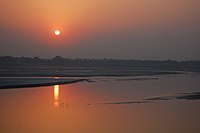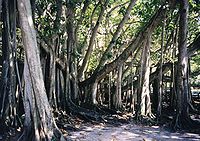بھارت کی قومی علامات
بھارت کے کئی قومی علامات ہیں جس میں تاریخی دستاویز، پرچم، قومی نشان، قومی ترانہ، یادگار ستون اور کئی قومی ہیرو شامل ہیں۔ تمام نشانات متعدد اوقات میں متعین کیے گئے ہیں۔ قومی پرچم کا ڈیزائن آزادی سے فوراً پیشتر 22 جولائی 1947ء کو مجلس قانون ساز کے رکن کے ذریعے پسند کیا گیا تھا۔و1و ان کے علاوہ کچھ قدیم علامات بھی ہیں جیسے قومی جانور، پرندہ، پھول، پھل اور درخت وغیرہ۔و2و
قومی علامات[ترمیم]
| ٹائٹل | علامت | تصویر | تفصیل |
|---|---|---|---|
| قومی پرچم | پرچم بھارت | 
|
A horizontal rectangular tricolor with equally sized deep saffron at the top, سفید in the middle and India green at the bottom. In the center is a navy blue wheel with twenty-four spokes, known as the اشوک چکر۔ The flag is based on the Swaraj flag designed by Pingali Venkayya۔[1] |
| قومی علامت | بھارت کا ریاستی نشان | 
|
An adaptation of Lion Capital of Asoka at سارناتھ was adopted as the National Emblem of India on 26 جنوری 1950, the day India became a جمہوریہ۔ Forming an integral part of the emblem is the motto inscribed below the abacus in دیوناگری script: "Satyameva jayate" (English: Truth Alone Triumphs)، a quote taken from Mundaka Upanishad، the concluding part of the sacred Hindu Vedas.[2] |
| بھارتی قومی تقویم | شکا تقویم | Saka calendar was introduced by the Calendar Committee in 1957, as part of the Indian Ephemeris and Nautical Almanac, which also contained other astronomical data, as well as timings and formula for preparing Hindu religious calendars. Usage officially started at 1 Chaitra 1879 Saka Era, or 22 مارچ 1957.[3] | |
| قومی ترانہ | جن گن من | جن گن من by رابندر ناتھ ٹیگور was officially adopted by the مجلس دستور ساز as the Indian national anthem on 24 جنوری 1950.[4] | |
| قومی گیت | وندے ماترم | The first two verses of بندے ماترم by بنکم چندر چٹرجی was adopted as the National song of India in 1950. "Vande Mataram" was sung during the 1896 session of the انڈین نیشنل کانگریس by رابندر ناتھ ٹیگور۔[5] | |
| عہد | قومی عہد (بھارت) | It was Written in Telugu by Pydimarri Venkata Subba Rao in 1962. Central Advisory Board on Education directed that the pledge to be sung in Schools and that this practice to be introduced by 26 جنوری 1965.[6] | |
| قومی پھول | بھارتی کنول | فائل:Nelumno nucifera open flower – botanic garden adelaide2.jpg | Lotus (کنول) is a sacred flower and occupies a unique position in the art and mythology of ancient India and has been an auspicious symbol of Indian culture.[7] |
| قومی پھل | آم | فائل:Mangifera indica (Manguier 4)۔jpg | Mango (Mangifera indica) originated in India and the country is home to more than 100 varieties of the fruit.[8] |
| قومی دریا | گنگا | 
|
Ganga is the longest river of India with the most heavily populated river basin in the world. The river is revered by Hindus as the most sacred river on earth.[9] |
| قومی پیڑ | بھارتی برگد | 
|
Indian banyan (Ficus bengalensis) root themselves to form new trees and grow over large areas. Because of this characteristic and its longevity, this tree is considered immortal and is an integral part of the myths and legends of India.[10] |
| قومی جانور | رائل بنگال ٹائگر | 
|
Bengal tiger (Panthera tigris tigris)، the largest carnivore is found only in the Indian subcontinent and can be found in most regions of the country.[11] |
| قومی آبی پرندہ | دریائی ڈولفن[12] | 
|
Gangetic dolphin (نابینا ڈولفن) is said to represent the purity of the holy دریائے گنگا as it can only survive in pure and fresh water.[13] |
| قومی پرندہ | مور | 
|
Indian peacock (ہندوستانی مور) is designated as the national bird of India. A bird indigenous to the subcontinent, peacock represents the unity of vivid colors and finds references in Indian culture.[14] |
| قومی کرنسی | بھاری روپیہ | 
|
بھارتی روپیہ (ISO code: INR) is the official currency of the Republic of India. The issuance of the currency is controlled by the ریزرو بینک آف انڈیا۔ The Indian rupee symbol is derived from the Devanagari consonant "र" (ra) and the Latin letter "R" was adopted in 2010.[15] |
حوالہ جات[ترمیم]
- ↑ "National Flag"۔ Government of India۔ 25 دسمبر 2018 میں اصل سے آرکائیو شدہ۔ اخذ شدہ بتاریخ 3 مارچ 2014
- ↑ "State Emblem"۔ Government of India۔ 25 دسمبر 2018 میں اصل سے آرکائیو شدہ۔ اخذ شدہ بتاریخ 3 اپریل 2012
- ↑ "National Calendar"۔ Government of India۔ 25 دسمبر 2018 میں اصل سے آرکائیو شدہ۔ اخذ شدہ بتاریخ 3 اپریل 2012
- ↑ "National Anthem"۔ Government of India۔ 25 دسمبر 2018 میں اصل سے آرکائیو شدہ۔ اخذ شدہ بتاریخ 3 اپریل 2012
- ↑ "National Song"۔ حکومت ہند۔ 25 دسمبر 2018 میں اصل سے آرکائیو شدہ۔ اخذ شدہ بتاریخ 3 اپریل 2012
- ↑ Arabinda Biswas، S. P. Agrawal (1 جنوری 1986)۔ Development of education in India: a historical survey of educational documents before and after independence۔ Concept Publishing Company۔ صفحہ: 140۔ ISBN 978-81-7022-066-4۔ 25 دسمبر 2018 میں اصل سے آرکائیو شدہ۔ اخذ شدہ بتاریخ 27 جنوری 2012
- ↑ "National Flower"۔ Government of India۔ 25 دسمبر 2018 میں اصل سے آرکائیو شدہ۔ اخذ شدہ بتاریخ 3 اپریل 2012
- ↑ "National Fruit"۔ Government of India۔ 25 دسمبر 2018 میں اصل سے آرکائیو شدہ۔ اخذ شدہ بتاریخ 3 اپریل 2012
- ↑ "National River"۔ Government of India۔ 25 دسمبر 2018 میں اصل سے آرکائیو شدہ۔ اخذ شدہ بتاریخ 3 اپریل 2012
- ↑ "National Tree"۔ Government of India۔ 25 دسمبر 2018 میں اصل سے آرکائیو شدہ۔ اخذ شدہ بتاریخ 3 اپریل 2012
- ↑ "National Animal"۔ Government of India۔ 25 دسمبر 2018 میں اصل سے آرکائیو شدہ۔ اخذ شدہ بتاریخ 3 اپریل 2012
- ↑ http://www.archive.india.gov.in/knowindia/national_symbols.php?id=8
- ↑ "National Aquatic Animal"۔ Government of India۔ 25 دسمبر 2018 میں اصل سے آرکائیو شدہ۔ اخذ شدہ بتاریخ 3 اپریل 2012
- ↑ "National Bird"۔ Government of India۔ 25 دسمبر 2018 میں اصل سے آرکائیو شدہ۔ اخذ شدہ بتاریخ 3 اپریل 2012
- ↑ "Currency Symbol"۔ Government of India۔ 25 دسمبر 2018 میں اصل سے آرکائیو شدہ۔ اخذ شدہ بتاریخ 12 نومبر 2012
بیرونی روابط[ترمیم]
- knowindia.gov.in – National Symbolsآرکائیو شدہ (Date missing) بذریعہ knowindia.gov.in (Error: unknown archive URL)
- National Symbols Government of India Official website.

